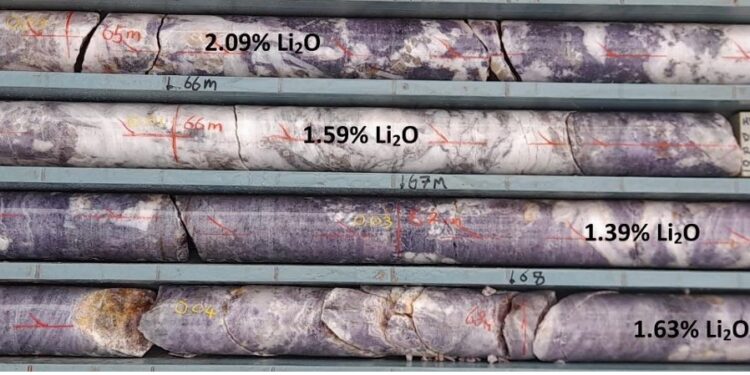Metals Australia Ltd (ASX: MLS) has obtained a high-grade lithium pegmatite diamond drilling intersection from the Foundation Pegmatite at the Manindi Project, 20km southwest of Youanmi in Western Australia’s highly prospective Murchison District.
The latest high-grade lithium results are from drillhole MND005 which tested the highest-grade zone of the Foundation Pegmatite, which previously produced rockchip grades of up to 2.30% Li2O1. The diamond hole intersected a 12.5m true-width zone of steeply dipping pegmatite with visible lepidolite and petalite crystals throughout, producing the 12m intersection grading 1.38% Li2O including 3m @2.12% Li2O.
The high-grade lithium-bearing pegmatite has been drilled to more than 120m below surface and remains open at depth.
“The latest diamond drilling results demonstrate both the high-grade and continuity of the Foundation lithium-bearing pegmatite on our Manindi Project in WA,” Chairman, Mike Scivolo, said.
“This has given us the confidence to commit to the next stage of work at Manindi, involving metallurgical testwork to examine the potential to produce lithium concentrate on site, while also assessing downstream processing options for production of high-value lithium products in WA.
“Positive results from this work will lead to resource delineation and examination of development options for this exciting new Australian lithium project.”
Previous rockchip sampling of this recent high-grade pegmatite discovery produced results averaging over 1% Li2O along the entire 500m strike length of the identified pegmatite zone. This was confirmed by RC drilling which tested the Foundation Pegmatite as part of the 3,500m RC drilling programme in 2022, producing widespread lithium intersections within a 3km x 1km NW-SE trending pegmatite corridor.
Metallurgical Testwork Programme
A metallurgical testwork programme has been initiated at Manindi, based on a more than 40kg drill-core bulk sample from MND005 grading 1.33% Li2O.
The testwork, to be carried out at Nagrom laboratories in Perth and managed by CPC Engineering, will initially examine potential to produce a lepidolite-petalite concentrate targeting 3-5% lithium grade. The company is in discussions with potential offtakers for such a concentrate.
Potential also exists to convert the alumino-silicate mineral petalite (LiAlSi4O10), to the higher-grade lithium mineral, spodumene (LiAl(SiO3) via low temperature roasting to ~500 °C and under three kbar of pressure in the presence of alkali borosilicate fluid with a minor carbonate. Petalite (and secondary spodumene formed from it) is lower in iron than primary spodumene, making it a more useful source of lithium.
A second stage of metallurgical testwork will examine potential for down-stream processing to leach the lepidolite and petalite (and/or converted spodumene) concentrate then precipitate high-value lithium carbonate as well as other in-demand products such as rubidium, cesium and tantalum.
Subject to positive results from the metallurgical testwork and offtaker discussions, a Mineral Resource delineation drilling programme will be carried out as well as preliminary economic development studies.
For further information please visit: https://metalsaustralia.com.au/












